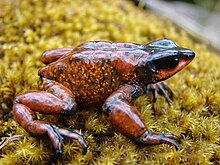Guajira stubfoot toad
| Guajira stubfoot toad | |
|---|---|

| |
| Scientific classification | |
| Domain: | Eukaryota |
| Kingdom: | Animalia |
| Phylum: | Chordata |
| Class: | Amphibia |
| Order: | Anura |
| Family: | Bufonidae |
| Genus: | Atelopus |
| Species: | A. carrikeri |
| Binomial name | |
| Atelopus carrikeri Ruthven, 1916 | |
| Synonyms | |
|
Atelopus leoperezii Ruiz-Carranza, Ardila-Robayo & Hernández-Camacho, 1994 | |
The Guajira stubfoot toad[1] or Carrikeri harlequin frog[2] (Atelopus carrikeri) is a species of toad in the family Bufonidae.[3] It is about 5 cm (2.0 in) long and typically black, though some populations have orange coloration.[4] This species is endemic to the Sierra Nevada de Santa Marta mountain range of northern Colombia.[1][3] It is critically endangered because of the chytrid fungus, Batrachochytrium dendrobatidis, and habitat destruction due to agriculture. The species had not been seen from 1994 until it was rediscovered in early 2008.[1]
Taxonomy
This species was initially described by Alexander G. Ruthven in 1916 from specimens collected by M. A. Carriker Jr., in 1914.[5] In 1994, a new species, Atelopus leoperezii, was described,[6] only to later be determined to be the Guajira stubfoot toad.[7] Its closest relative is believed to be Atelopus ignescens of Ecuador.[5]
Description
The frog is about 5.0 cm long.[4] It has at least two color phases, with the rarer orange population being the one recently rediscovered.[4] However, the frog is typically all black, although it is a slightly lighter shade on its belly.[5] In adults, the skin is smooth except for a patch of spiny warts on the side. The area that these warts cover varies, with some specimens displaying them from their eyes to their arms and others displaying it from their eyes to their femurs. One specimen even had the warts covering the entire body. The Guajira stubfoot toad has short legs with rounded fingers and toes. While its fingers are unwebbed, its toes are broadly webbed, though its first toe is distinct. Its head is as broad as it is long.[5]
Distribution and habitat
It is endemic to about 627 km2 (242.1 sq mi) in northern Colombia.[7] Its natural habitats are sub-Andean and Andean cloud forests, and páramo. In addition, it is known to survive in snow-covered areas. It is found at elevations between 2,350 and 4,800 m. It can tolerate some habitat modification, but habitat loss caused by agriculture remains a threat.[1]
Ecology
This species lays its eggs in chains in freshwater mountain streams, where its tadpoles develop.[8]
Conservation
While the frog was common historically, it is currently endangered due to habitat loss from agriculture, climate change, crop fumigation, and, most significantly, the virulent chytrid fungus, Batrachochytrium dendrobatidis.[1][7] This fungus was predicted to lower the population of the species by over 80%.[2] This toad was rediscovered after an absence of 14 years by a Project Atelopus team in early 2008 in the Sierra Nevada de Santa Marta mountains of Magdalena, Colombia.[1][2]
References
- ^ a b c d e f g IUCN SSC Amphibian Specialist Group (2017). "Atelopus carrikeri". IUCN Red List of Threatened Species. 2017: e.T54496A49534770. doi:10.2305/IUCN.UK.2017-3.RLTS.T54496A49534770.en. Retrieved 15 November 2021.
- ^ a b c Waterman, Carly (2008-03-18). "Missing in Action!". EDGE. Retrieved 2008-03-26.
- ^ a b Frost, Darrel R. (2014). "Atelopus carrikeri Ruthven, 1916". Amphibian Species of the World: an Online Reference. Version 6.0. American Museum of Natural History. Retrieved 7 October 2014.
- ^ a b c "Critically Endangered Harlequin Frog Rediscovered in Remote Region of Colombia". Wildlife Extra. March 2008. Retrieved 2008-03-26.
- ^ a b c d Ruthven, Alexander G. (May 25, 1916). "Description of a new species of Atelopus from the Santa Marta Mountains, Colombia" (PDF). Occasional Papers of the Museum of Zoology. 1 (28): 1–3. Retrieved 2008-03-26.
- ^ Ruiz-Carranza, P. M.; Ardila-Robayo, M. C.; Hernández-Camacho, J. I. (1994). "Tres nuevas especies de Atelopus A.M.C. Dumeril & Bibron 1841 (Amphibia: Bufonidae) de la Sierra Nevada de Santa Marta, Colombia" (PDF). Revista de la Academia Colombiana de Ciencias Exactas, Físicas y Naturales. 19: 153–163. Archived from the original (PDF) on 2016-03-04. Retrieved 2017-08-18.
- ^ a b c "Atelopus carrikeri". Global Amphibian Assessment. NatureServe. May 2006. Archived from the original on 2011-07-17. Retrieved 2008-03-26.
- ^ "Atelopus carrikeri". AmphibiaWeb. October 2004. Retrieved 2008-03-26.

